Welcome Chefs!
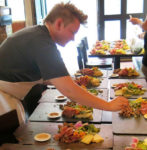
We work with chefs, caterers, and student chefs for special menus, events and competitions.
One of the tests of premium lamb and goat meat is taste and our meat and fat tastes as pure and clean as the environment in which the lambs and kids grow. Strong and overpowering spices are not required.
Production of the Meat
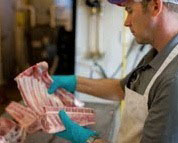
Production of high quality meat requires careful planning and attention throughout each stage of life, slaughter and processing. The events that occur before and after slaughter determine the quality of all meat coming from the carcass. Animals exposed to stressful living conditions (e.g. overcrowded pens, poor sanitation, rough handling) will become chronically exhausted. After slaughter the muscles will not produce enough lactic acid to induce the proper drop in pH levels. Meat with high pH is often noted to be dark, dry and firm. Animals that are threatened, surprised or excited within a half hour prior to slaughtering (e.g. panicked, threatened, unstable footing, unexpected noises or lighting) will release an adrenalin rush and a sudden fall in the pH of muscles after slaughter. This adrenaline rush spurs accelerates processing of glycogen and increased lactic acid production with a sudden shift of pH from neutral to acidic. When combined with warm muscles this causes the meat fibers to unravel excessively causing pale, soft and exudate meat.
Relaxed, comfortable animals are important ethically and also for the highest quality product.
Handling of the Carcass
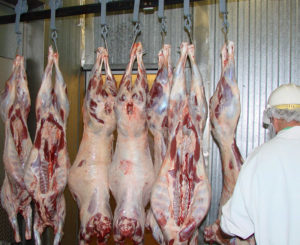
Handling the carcass after the slaughter is also critical for a quality product. Chill too quickly and the consequence is incredibly tough meat caused by a process called cold shortening. This occurs when the temperature of the meat drops below 59 degrees F before the onset of rigor mortis. A similar condition called thaw shortening happens when meat from freshly slaughtered carcass is frozen prior to the onset of rigor mortis. Even when all preceding conditions are carried out to the ideal, improper storage procedures have the potential to compromise the final quality of meat (e.g. temperature variation, air contamination in the packaging, temperature ranging above specified degree). Whereas properly packaged and frozen meat maintains the positive qualities of fresh meat. Preference for fresh is often due to negative experience with improperly chilled and stored meat products.
A Sustainable Agriculture
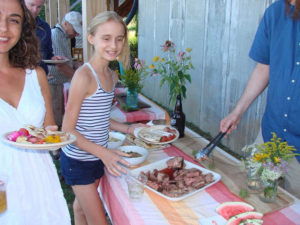 We practice sustainable agriculture without the government subsidizes common for industrial farming. Our lambs and kids are free to run, jump and explore their environment. We move small groups of sheep and goats with their offspring all summer to fresh pasture as nature intended. Their diet includes native grasses, clovers, and wild blossoms or cultivated flowers when they can snatch one in passing. They are protected from predators by guardian dogs, llamas and strategic planning during their most vulnerable early weeks. During winter months they are fed a high nutrition diet of harvested grass and alfalfa hay that is significantly more expensive than the corn and ethanol byproduct ration fed commodity lambs and kids in confinement. This all requires more land per animal, labor and investment in feed, and infrastructure such as fencing and humane handling facilities. However we believe it is well worth it.
We practice sustainable agriculture without the government subsidizes common for industrial farming. Our lambs and kids are free to run, jump and explore their environment. We move small groups of sheep and goats with their offspring all summer to fresh pasture as nature intended. Their diet includes native grasses, clovers, and wild blossoms or cultivated flowers when they can snatch one in passing. They are protected from predators by guardian dogs, llamas and strategic planning during their most vulnerable early weeks. During winter months they are fed a high nutrition diet of harvested grass and alfalfa hay that is significantly more expensive than the corn and ethanol byproduct ration fed commodity lambs and kids in confinement. This all requires more land per animal, labor and investment in feed, and infrastructure such as fencing and humane handling facilities. However we believe it is well worth it.
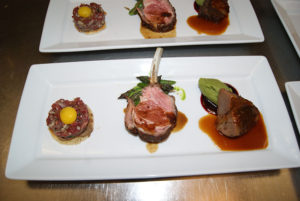
We owe the animals we partner with a natural life with a respectful death. Stressing through poor environments, nutrition or mishandling is not beneficial for either the animal or for us. We are in this together. We do not turn away from the slaughter process. We are there throughout the life cycle, transport, unloading, slaughter and processing. We use a USDA small slaughter facility (under 15 employees paid a living wage) exactly for this purpose. Larry or our employee transports and supervises the unloading and handling process. Larry is always present to supervise the cutting, packaging and freezing process and monitors the meat temperature throughout the process for ultimate meat quality.
Contact us directly for more information and pricing. For additional slaughter information visit our website www.spiritofhumane.com
…We took the meat off the rack, seared it and served it as a goat rib eye. The lead judge for the entree was Walter Scheib, former White House executive chef for 11 years. He said in 45 years of being in the restaurant business he had never seen anyone take on making a goat tasting menu the way our team did, much less pull it off as teenagers. He raved about how impressed he was with the students for taking on a challenging ingredient like goat meat and cooking it so tender. It was quite a compliment from him, and was only possible because of the great product you sent to us!
– Chef Chris Moree
National ProStart Invitational
May 3-5, 2014. Minneapolis, MN
